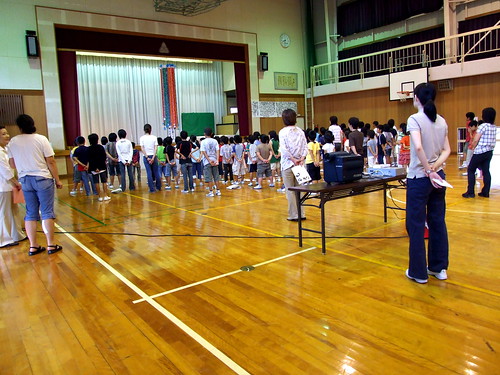Last night around one, just as I was turning down the covers, Mana called to me from the balcony. She was going to give a talk at an elementary school in the morning--could I come? Thursday is a work day for me, so of course the answer was yes. Unfortunately the next thing she said was "Let's leave at 7." Ouch.
Anyway, the next morning, Mana and the peace museum director and I set out for Aki, a small town about one hour by car from Kochi. The drive alone turned out to be well worth waking up early. On the way, we passed through a lovely wide plain, full of the biggest rice fields I've seen yet (about half the size of the average SK wheat field), and in the back seat I had an excellent view of Kochi's hills fading into the distance. We drove along the coast for a little ways, too, and it was a really nice view as the Pacific Ocean goes. The elementary school we were bound for was even more charming. Aki is a hilly area, and it was a cloudy day, the kind of clouds that are lower than the hills. The school is right next to some rice fields, and the view through two of the school's buildings to brilliantly green rice fields to misty mountains was wonderful. (Alas, no photos.)
But that's not the good part! Mana was giving a lecture about Grass Roots House and about peace to the grade four, five, and six students. We arrived half an hour early, and watched the entire school in an assembly. The school had recently made about 3000 paper cranes, which were arranged in strings and hanging on the stage. To open the assembly, they sang a beautiful little song about peace. (I'll post the lyrics in English here some time soon, I hope.) Then the principal spoke, and after that one student from each grade showed a piece of calligraphy they had done and read it aloud. They were simple child statements like "War is bad," but I was incredibly impressed by the fact that these kids, from age five or six, were already thinking about serious world issues. Can we say the same in Canada?
I think Japan has a really bad rep for its history curriculum--war crimes are not in textbooks, things like that. Today I really saw another side. Of course, I don't know what is or isn't in the textbooks, but Canadian elementary school history textbooks lie, too, both by omission and in flat out untruths. I think it's amazing that Japanese schoolchildren talk about how important peace is in school, that they hear about things like Article 9.
At least as far as I recall, I didn't hear about doing our part to make peace in the world in school except on Rememberance Day. (Please tell me I'm wrong!) But clearly here, it doesn't take a national holiday to bring up this topic, and they ask that their first grade students speak up about it, not just lay a wreath. There is a Peace Tanabata Festival coming up in July, but it wasn't a holiday today. (In fact, isn't that more amazing? There's a local yearly festival here that's about peace. More on that in July.)
I had a chance to say something to the grade four five and sixes, and while I was scared out of my pants that I would make a grade three level grammatical mistake, I told them that this experience they were having was incredibly valuable, that not everyone in the world hears this kind of conversation in elementary school and that they should feel very lucky to have access to it, and do their best to think hard about what they were learning. (Much less eloquently, because hey, Japanese is hard.)
Mana tells me that this kind of assembly and conversation used to be common practice in Japan, but that it is becoming more rare. I say, good job to the schools that are continuing it--and may it spread, not shrink.
19 June, 2008
Peace in the Classroom
Subscribe to:
Post Comments (Atom)


1 comment:
you never cease to amaze. you already know this, but I love the way you write and think about things.
clearly this is why we are best friends.
E
Post a Comment